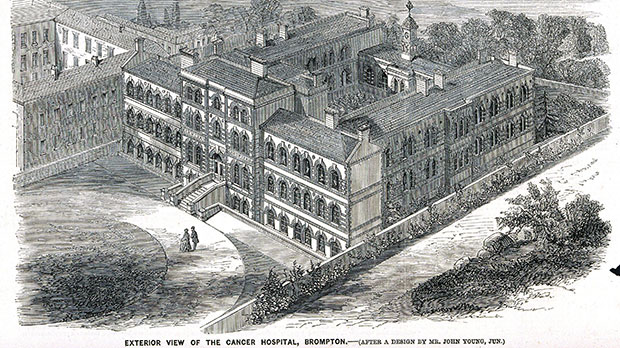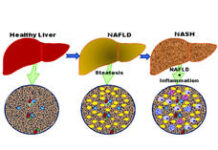 Credit: The Free Cancer Hospital, Kensington, London: aerial view. Wood engraving, 1859. Wellcome Collection. Public Domain Mark
Credit: The Free Cancer Hospital, Kensington, London: aerial view. Wood engraving, 1859. Wellcome Collection. Public Domain Mark
Do you know why it’s called cancer?
“The first identification of the word cancer is from the Ancient Greeks. They used the term ‘karkinos’, which translates in Latin to canker or cancer to describe a particular kind of tumour,” explains Dr Alanna Skuse.
“The word ‘karkinos’ actually means crab, because like a crab, the body of the tumour is round and red. And like a crab, it would grab hold of the person and not let go.”
But beyond just influencing why we call it ‘cancer’, the history of cancer has also had a huge impact on the way we view, and even treat cancer, today.
A lecturer in English Literature at the University of Reading, Skuse has a particular interest in how people wrote and thought about bodies and medicine in the Renaissance and early modern period in Britain.
From the language we use to talk about cancer, to the cancer types that receive the most funding, there’s a lot that we don’t realise has been hugely influenced by the past, she explains.
“Cancer is a really good example of science and culture being intertwined with each other, and not really being very easy to separate out.”
 100vw, 240px”></p>
<p class=) Credit: A sword slaying the hydra; representing the fight against cancer. Colour lithograph after G. Georget, 1960. Wellcome Collection. In copyright
Credit: A sword slaying the hydra; representing the fight against cancer. Colour lithograph after G. Georget, 1960. Wellcome Collection. In copyright
The anthropomorphism of cancer
A crab isn’t the only animal that cancer has been compared to.
“In the 17th century people talked about cancer as being like an animal that ate the body of the sufferer,” explains Skuse.
“People called cancer the wolf, because it ‘ate up’ the person.”
But this wasn’t just a linguistic quirk. The idea was actually translated into practice.
“Some doctors would even apply raw meat to a cancerous ulcer, so that the wolf could feast on that for a while instead of ‘eating’ the patient. But the cultural idea also influenced scientists, who had just got hold of microscopes on a large scale.”
When scientists began examining tumour cells in more detail, they concluded that cancer was alive in an animate sense – that it was almost parasitic.
“It has massively influenced how we talk about cancer now,” adds Skuse. “We have a language for cancer that is much more adversarial than with other diseases. We’re always talking about ‘we’re going to kick cancer’s butt, we’re going to battle cancer’ and so on.”
The history of cancer is particularly salient. Because so much of what we do around cancer seems to be influenced by rhetoric that we might not even know why we’re using it. But it is really strong, this rhetoric of battling cancer or cancer being a kind of entity that we need to fight or defeat or kill.
Dr Alanna Skuse
At Cancer Research UK, we know that ‘violence’ metaphors can, in some circumstances, cause harm.
In fact, some research has found that the use of war metaphors and battle language around cancer could create more fear around treatment and leave people feeling more fatalistic about a diagnosis. This language didn’t just influence how we talk about cancer today, but also how we treat it.
In fact, the terminology that developed in the 17th century contributed to the perception of cancer as an ‘enemy’, so much so that doctors first decided to treat it very aggressively with poisons. During this time, arsenic and mercury were prescribed as treatments in the hope that they would kill the cancer before they killed the patient. And those were effectively the first chemotherapies.
“The other thing to consider is that the adversarial narrative that we’ve inherited from history has fostered an environment in which heroic cures for cancer (brand-new drugs, or brand-new surgical procedures) are given far more emphasis than incremental improvements to existing therapies, or prevention of disease, or early and accurate diagnosis,” adds Skuse. “These are all things that could improve outcomes for people, but they don’t all have the same ‘battling the beast’ kind of resonance.
”If you want to hear more from Dr Alanna Skuse, have a listen to the latest episode of our podcast, That Cancer Conversation, titled ‘Why haven’t we cured cancer?’
Language and humour
Medieval medicine was largely based on the concept that the human body was composed of 4 different fluids, known as ‘humours’.
The humours – blood, yellow bile, black bile, and phlegm – were believed to determine a person’s temperament. If the humours became imbalanced, it would lead to ill health.
While the concept originated from the ancient Greeks, the theory persisted in various forms all the way through the medieval period and into the Renaissance.
In fact, the concept of the 4 humours was so important in the understanding of European medicine that it influenced the disposition of many of Shakespeare’s renowned characters.
“At the same time, we start to see different medical models coming in, which are a little bit closer to what we would think of as a modern understanding of medicine,” explains Skuse. “But because the humours are so deeply ingrained in society by that point, it’s very slow for them to actually recede from public awareness.”
So even into the 19th century, although doctors had developed a different understanding of medicine, the 4 humours were still largely how people were aware of their own bodies, and they still used that language in their everyday lives.
“It’s interesting to think about how that belief in a melancholy humour [black bile] causing cancer might have translated forwards to beliefs that a lot of people seem to have today,” Skuse considers.
She points out the misconception “that people who are very stressed or have very negative things happen to them in their lives are more likely to get cancers.”
Cancer contagion and stigma
Language isn’t the only thing that influenced our perception, and treatment, of cancer today.
In the 18th and 19th centuries, the number of cancer diagnoses began to increase. This was partly because, as the plague began to subside, people were more likely to live longer and therefore more likely to die of cancer, but also because doctors were getting better at identifying and diagnosing cancer.
As cancer cases began to rise, and the industrial revolution unfolded in Britain, it became more apparent that some groups of people were more likely to get cancer. For example, chimney sweeps, who came into contact with carcinogens in soot, started getting cancer at a relatively high rate. “And unfortunately, this led some people to draw the conclusion that cancer was actually contagious,” says Skuse.
During the medieval period some people believed cancer was a form of leprosy, but the idea of cancer being contagious resurfaces in the 18th Century. “So in 1779, the first dedicated cancer hospital was founded in Reims in France, but it was forced to move, partly because people feared that it was going to spread,” Skuse says.
The fear of catching cancer actually had a long hangover and really contributed to the stigmatisation of cancer. “So that even until very recently, we’d say that people died after a long illness, instead of saying they died of cancer.”
‘A woman’s disease’

Credit: Breast cancer, 16th Century. Wellcome Collection. Attribution 4.0 International (CC BY 4.0
While it began to emerge that some external factors could influence the chances of developing cancer, one theory about who was more likely to get cancer persisted.
“From a very early stage, certainly from the medieval period onwards, cancer was believed to be a disease that mostly affected women. And it’s a kind of chicken and egg situation,” explains Skuse.
This was partly because breast cancers were easier to spot and diagnose than other cancers. But doctors also believed that women’s bodies in particular, needed to regularly get rid of humours in order to stay healthy.
“The primary way women were believed to get rid of their humours was through menstruation,” says Skuse. “So, if a woman stopped menstruating, say at the menopause, she was then at risk of cancer.”
At the time, as well as being one of the most recognised cancers, breast cancer was one of the few cancers that surgeons would attempt to treat surgically, with a mastectomy. This was long before the invention of anaesthetic.
“Women who had these operations were incredibly brave,” adds Skuse.
An early first-person account of cancer treatment is from a novelist called Frances Burney. Burney had a mastectomy in 1811. And afterwards she wrote to her sister, where she described how she could feel and hear the knife scraping against her ribs.
Oh no! presently the terrible cutting was renewed – & worse than ever, to separate the bottom, the foundation of this dreadful gland from the parts to which it adhered – Again all description would be baffled – yet again all was not over, – Dr. Larry rested but his own hand, & – Oh heaven! – I then felt the knife (rack)ling against the breast bone – scraping it!
An extract from Frances Burney’s letter to her sister.
The bravery of the women willing to undergo these surgeries likely contributed to the idea of cancer being ‘a women’s disease’ and this idea was carried through centuries, for good and bad.
“It means that today breast cancer funding can often outstrip funding for other kinds of cancer. But it also means that cancer has been associated with stigmatised times in women’s lives, particularly the onset of menopause.”
The importance of looking back
Cancer is often about looking forwards, to the horizon, to the latest treatments and cutting-edge technology.
And whilst scientific research is often advancing, it’s helpful to think about how the past has influenced what we see around us today.
“We often imagine that science is this sort of shining thing that sits completely apart from the rest of life,” add Skuse. But crucially, as she points out, scientists only get the answers to the questions they ask.
“Scientists are human beings and the questions they ask are influenced by cultural and political factors – what people want to see and what governments want to fund. Looking at the history of medicine is an important reminder of this.”
Lilly





